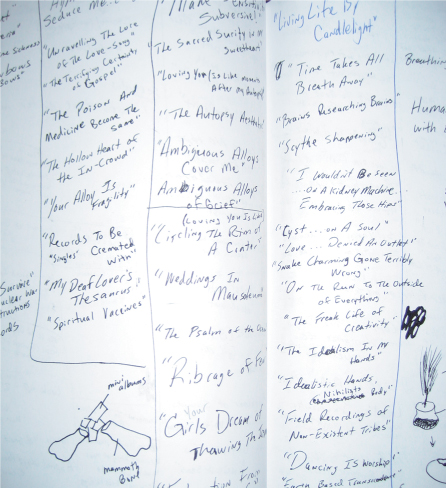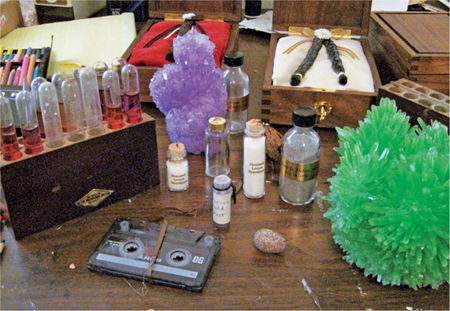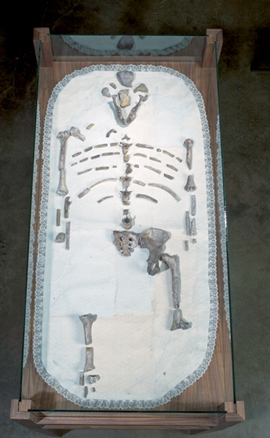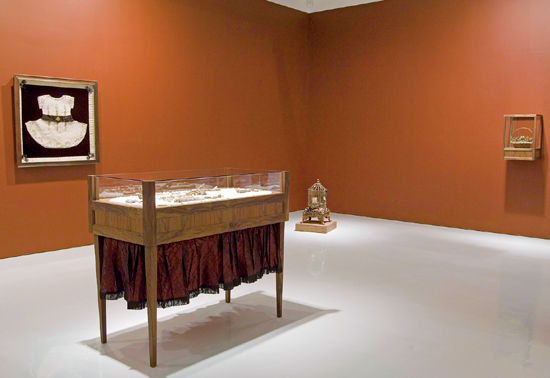YOU CAN HAVE A GENUINELY ORIGINAL, AUTHENTIC THOUGHT, EVEN IF IT’S USING THE SCRAPS AROUND YOU.
I’m a big advocate of cross-disciplinary influences, and the passions I have in other fields outside of typical art |are my main sources of inspiration. For example, I’m a big history buff. I’m also a big rock and mineral collector and I love science. I love music and I take being a fan very seriously. So, all those things play into how I go about making things. I’m constantly crossing over, looking for juxtapositions. I’ll make a weird composite of all these influences before I start a project. I don’t really sit down and consciously think about it; it just happens. It’s such a natural way of making things for me.
I’m really inspired by my passions and interests. I always encourage young artists to use their personal experiences—things they love or are ashamed of. That’s exactly where you should be starting as your source of inspiration.
I’m very reluctant to take photos. I have a theory about the importance of individual memory, especially in the context of a hyper media world. I like the idea that everything’s riding on your memory. So, when I go on trips, I rarely take a camera with me. I’m not opposed to it. It’s just a strategy I’ve come up with over the years that makes me so in the moment that I have to take a snapshot of everything in my mind.
I do take extensive notes, though. I’m constantly writing things down, like material lists or titles. I’ve discovered I will remember something as language, words on paper. Occasionally, I’ll make little sketches, but that’s pretty rare. I’m such a child of pop music that my mind operates on the song title and lyrics. The length of my writing often is much like the beauty of a song title, where you have to get to the point in one phrase.
I never learned how to play an instrument. I was always worried that I wasn’t going to have anything to contribute if I ever got into a band. So, as a kid, I started coming up with song titles or band names rather than the actual music. I still keep an ongoing tally of great band names and song titles. I’ve given up hoping that I’m going to be in a band at this point, so I use all those names and titles toward my work.

The most structured things that I have in my notebook are the columns of titles that I’m constantly writing. Something will strike me, like a history book or a battle in the Revolutionary War, and I will filter it into a song title. I ask myself, what would be the perfect title for this event if it was going to be a pop song?
I’m also constantly writing new material lists. These could be things that may not even exist. I will just write down the material for the joy of it. For example, I had written down the term Icelandic lava. I just really liked those syllables and consonants together. It was the idea of the Earth’s hot, boiling material in a very cold place. So, my material lists will grow out of playing with words, and then I will get to the object.
It’s kind of a backward approach to object making. I don’t know any other sculptor who does it this way, because most sculptors begin with the object, and language is tacked on, if at all, at the end.
Growing up in a postmodern age and being heavily invested in DJ culture, I’ve spent many years thinking about the authenticity question. The backbone of that culture is sampling. Along the way, it has made me focus on the question of authenticity and originality. Does the definition of those two things have to be that it occurs from zero?
Sampling is reinventing the notion of originality. You can have a genuinely original, authentic thought, even if it uses the scraps around you. There’s a beautiful philosophy in knowing a universe exists in the scraps around you, if you just know how to access it or tease out new, hidden meanings. That’s liberating for me because it implies that everyone can be original. It implies that the new meaning of the object hinges on the history of the previous object. Sampling, of course, originates in music, but in my world it’s applied to materials as well, not just song snippets.
I have a sort of populist attitude in my art. I did a piece reimagining Lucy, known as the forerunner of the human race. It’s called “She Can’t Dream for Us All.” Lucy’s been in the back of my mind since I was a kid. I’ve always been fascinated with her. What really sealed the deal for me when I was a kid was when I heard that the scientist who discovered her happened to be playing “Lucy in the Sky with Diamonds” on the excavation site, and that’s how she got her name.

This is a materials list of my piece, “She Can’t Dream for Us All”: bone dust from every bone in the body cast and carved into the fossilized remnants of Lucy Australopithecus afarensis; bone cores filled with melted vinyl and audio recordings of Sylvia Plath reciting her poems “Daddy” and “Lady Lazarus”; homemade paper (pulp made from mothers’, wives’, and daughters’ letters to soldiers in the field from various wars); ground iron; calcium; water-extendable resin; pigments; lace; silk; walnut; and glass.
One of my passions as a kid was rocks and minerals and fossils merging with pop music in a quirky way. That’s why it’s always been close to my heart. I wanted to re-imagine Lucy from scratch. If we dug her up today and she was not made of what we thought she was made of, how would that change history and make us reevaluate what we are as humans? I was able to buy some bones from the replicas that have been made of her. And from the exact replica, I remolded each bone and recast it.
Lucy made us wonder about her family and how they might have mourned her. There is an interesting idea that mourning helped propel us forward from the first time we creatively mourned the loss of a loved one. It was that first time someone had the impulse to scream the guttural cry of loss. There is the idea that singing originated in these primitive, guttural cries that would have been induced from losing something.
I love the theory that mourning could have propelled humans to humanness, which leads to the history of singing, which leads to pop music, which is my passion. So, I wanted to reimagine Lucy with all these ideas in mind.
I asked myself, “If I had to pick one thing to define loss and mourning as a sound, what would it be, and what would loss sound like?” After thinking about it for a long time, I remembered the recordings of Sylvia Plath reciting her poems. That is as close to what the sound of loss could be.
Soon, soon the flesh
The grave cave ate will be
At home on me
And I a smiling woman.
I am only thirty.
And like the cat I have nine times to die.
This is Number Three.
What a trash
To annihilate each decade.
Excerpt, “Lady Lazarus,”
by Sylvia Plath
All of these things happened separately, but came together to influence “She Can’t Dream for Us All.” I have my memory of pop music as a child. At some point, I asked myself what mourning sounds like. I had the Plath recordings in the back of my mind from years ago. I knew about the theory of mourning cries as the origin of song. I thought of all those things independently, wrote them years apart in my notebooks. And then I just suddenly connected all those dots.

For Lucy, when I say the bone cores are filled, I wanted the idea that the sound of mourning was literally at the center of the bone, and that its song was pushing us forward, into humanness, from the inside out, and that we were made out of that. She’s laid out in a special case that I made for her, and she’s lying on a bed of homemade paper.


 ARTIST
ARTIST